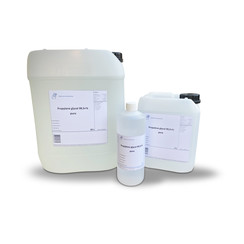You have no items in your shopping cart
Propylene glycol
Propylene glycol (IUPAC name: propane-1,2-diol), according to the National Library of Medicine and Agency for Toxic Substances and Disease Registry, is a synthetic liquid substance that absorbs water. It is labeled an organic compound in chemistry due to its carbon attributes. Its chemical formula is CH3CH(OH)CH2OH. It is a viscous, colorless liquid, which is nearly odorless but possesses a faintly sweet taste. Containing two alcohol groups, it is classed as a diol. It is miscible with a broad range of solvents, including water, acetone, and chloroform. In general, glycols are non-irritating, have very low volatility and very low toxicity.
It is produced on a large scale primarily for the production of polymers. In the European Union, it has the E-number E1520 for food applications. For cosmetics and pharmacology, the number is E490. Propylene glycol is also present in propylene glycol alginate, which is known as E405. Propylene glycol is a compound which is generally recognized as safe (GRAS) by the U.S. Food and Drug Administration (FDA) under 21 CFR x184.1666 and is also approved by FDA for certain uses as an indirect food additive. Propylene glycol is approved and used as a vehicle for topical, oral and some intravenous pharmaceutical preparations in U.S. and in Europe.


